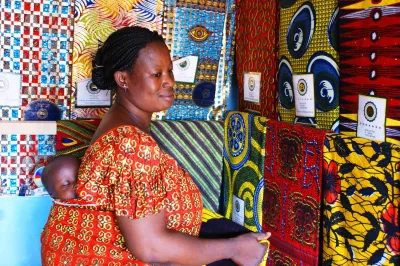Measuring Women’s Economic Empowerment in Financial Inclusion
What’s the best way to measure the impact of financial inclusion initiatives on women’s economic empowerment?
Within FinEquity, a community of practice hosted by CGAP that is dedicated to advancing women’s financial inclusion, we grapple with this question on a daily basis. While it can be difficult enough to measure the tangible results of financial inclusion initiatives, such as increases in women’s income and assets, it’s even more challenging to measure the subjective, context-specific aspects of empowerment like whether an initiative has increased women’s intra-household decision making and bargaining power.
Drawing on FinEquity’s experience and research mapping out relevant measurement frameworks and tools, below are some answers to common questions about how to measure the impact of financial inclusion initiatives on women’s economic empowerment.
How should women’s economic empowerment be defined?

The starting point for measuring women’s economic empowerment is defining what empowerment means. But because empowerment is a multi-dimensional and context-specific concept, there is no universally agreed upon definition of it.
Most frameworks recommend that practitioners conduct a gender analysis to help define what empowerment means when designing initiatives. Some also recommend approaches like Gender Progress Markers that enable program beneficiaries to define empowerment for themselves.
The general definitions below, found in the women’s economic empowerment frameworks of various organizations, can serve as a starting point for measuring the impact of a financial inclusion initiative on empowerment:
- “Women are economically empowered when they have both the ability to succeed and advance economically and the power to make and act on economic decisions” (ICRW)
- “A process by which women who have been denied the ability to make strategic life choices acquire such an ability” (J-PAL)
- “A dynamic process whereby resources enable women to have agency, or the ability to make decisions, through which women can achieve outcomes” (IFPRI)
- “An increase in women’s productivity, income, and wellbeing” (UN Foundation/Exxon Mobil Foundation)
What aspects of women’s economic empowerment are most important to measure?
It depends on the initiative. A characteristic that indicates empowerment in one context may be irrelevant or even reflect disempowerment in another. For example, making decisions about household purchases may empower women who are customarily denied this kind of authority. However, responsibility for making these decisions may be disempowering for women who feel that it is a burden rather than a choice.
Most frameworks recommend carrying out context-specific gender analysis and developing a theory of change to guide the selection of measurement domains and indicators. Theories of change differ because there are many pathways to advancing women’s economic empowerment. While a commonly agreed upon theory of change for achieving women’s economic empowerment does not exist, organizations like J-PAL and UN Foundation/Exxon Mobil have created guidelines on how you can develop one.
Despite their diversity, all of the women’s economic empowerment frameworks that FinEquity has mapped measure indicators within the following domains, which are highly applicable to financial inclusion initiatives:
- Access to resources such as capital, digital technologies, markets and business training
- Agency, such as control of resources and authority to make strategic decisions in households, businesses or communities
- Achievements, such as economic advancement, education and skill attainment, and the adoption and use of technology
Some of these frameworks also consider how women allocate time between productive and domestic tasks, their experiences of gender-based violence, and gender norms and rules concerning women’s role in the family and community.
What tools are available to help financial inclusion practitioners measure women’s economic empowerment?
There has been a proliferation of women’s economic empowerment measurement guides, indexes and indicators in recent years. Many of these resources, such as the recently published compendium by Data2X and CGD, are excellent and present a wide range of tools for use in different sectors of international development.
Last year, FinEquity’s Data & Measurement working group identified several tools that are particularly relevant for financial inclusion initiatives. This brief summarizes how each tool defines women’s economic empowerment, which domains it covers and which indicators it uses. It can serve as a reference guide for donors, INGOs, evaluators, researchers and other financial inclusion practitioners.
Some of the tools identified in the brief have already been tailored and applied in financial inclusion initiatives. For example, STARS, a Mastercard Foundation and ICCO Cooperation project, uses gender-sensitive value chain analysis to strengthen women’s cooperatives. The program also incorporates women’s economic empowerment considerations into household surveys and focus group discussions to identify context-specific barriers to women’s uptake of credit and to help providers develop better products for women.
Building on this research, FinEquity and its members are working to develop a shared approach to measuring economic empowerment within women’s financial inclusion initiatives.
What are common challenges in measuring women’s economic empowerment?
The resources identified by FinEquity discuss a range of challenges. J-PAL’s guide includes a comprehensive list and describes approaches to overcome them. Examples include:
- Measuring people’s ability to make important life choices is challenging because we rarely observe decision-making directly. This can be overcome by asking people about their specific decision-making processes and by asking multiple people in the household.
- Many aspects of empowerment are susceptible to reporting bias, so it is important to triangulate outcomes by using multiple indicators. Another solution is to frame questions indirectly by asking about hypothetical situations.
- Empowerment means different things in different contexts. It is essential to develop context-specific indicators and questions, pilot them extensively in the field before launching a survey, and complement context-specific indicators with more standard ones.
Measuring women’s economic empowerment can be difficult, but economic empowerment is one of the most powerful routes for women to achieve their potential and advance their rights. We encourage readers to refer to our brief to select or develop a measurement framework that best meets their needs. We also invite you to reach out to us to learn more about FinEquity’s work toward a common approach to measuring the impact of financial inclusion initiatives on women’s economic empowerment, as part of our newly launched Impact Pathways learning theme.




Add new comment